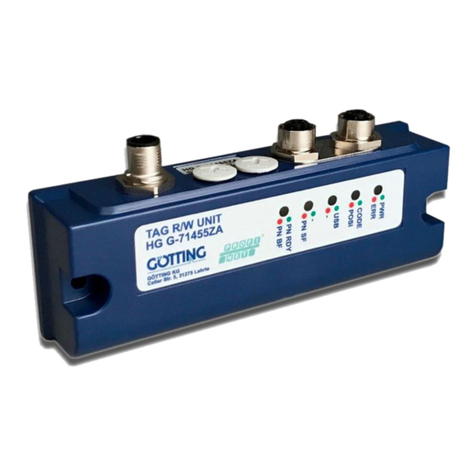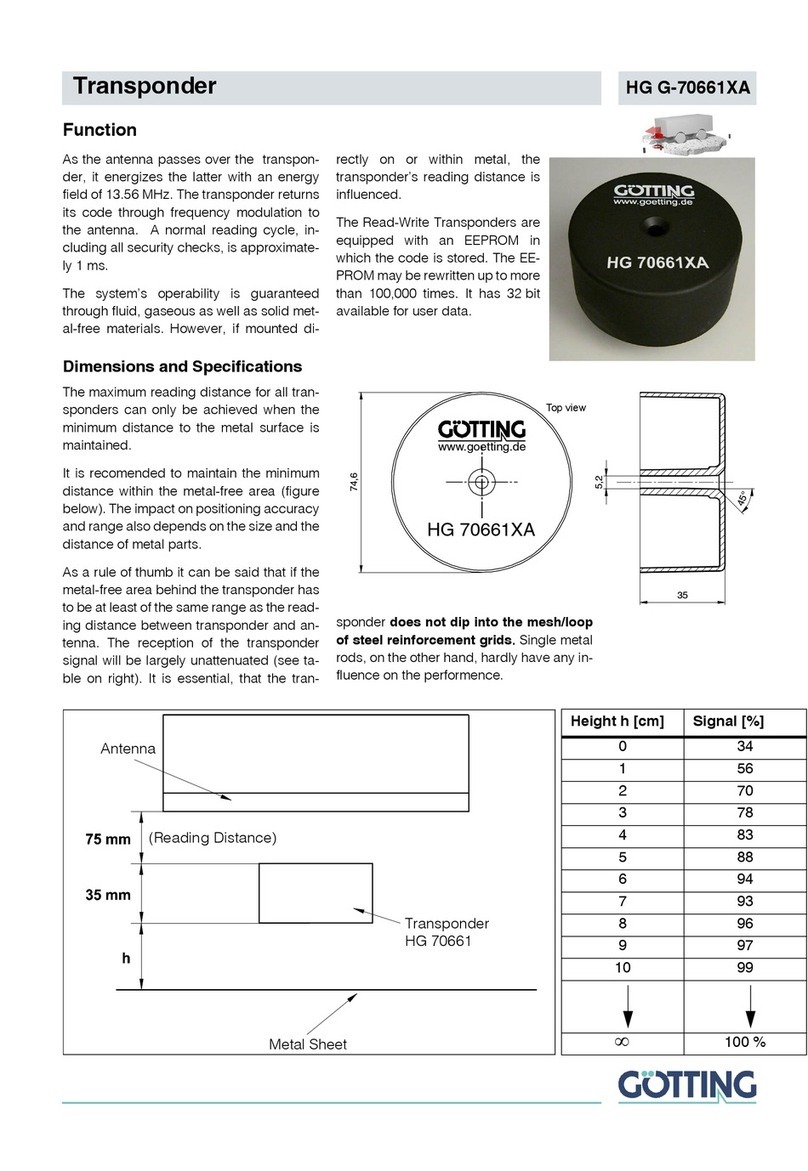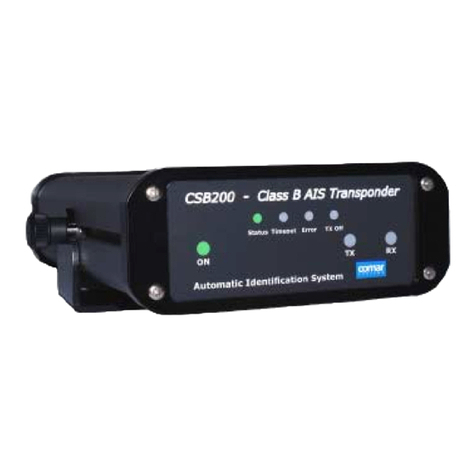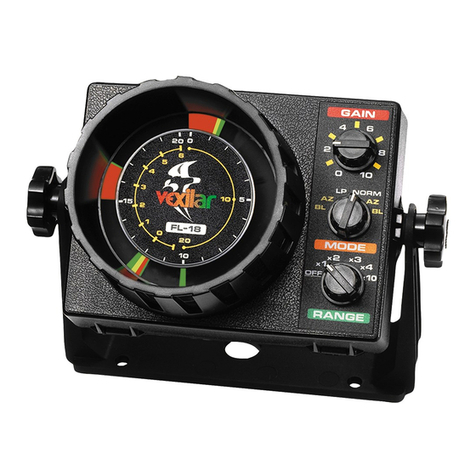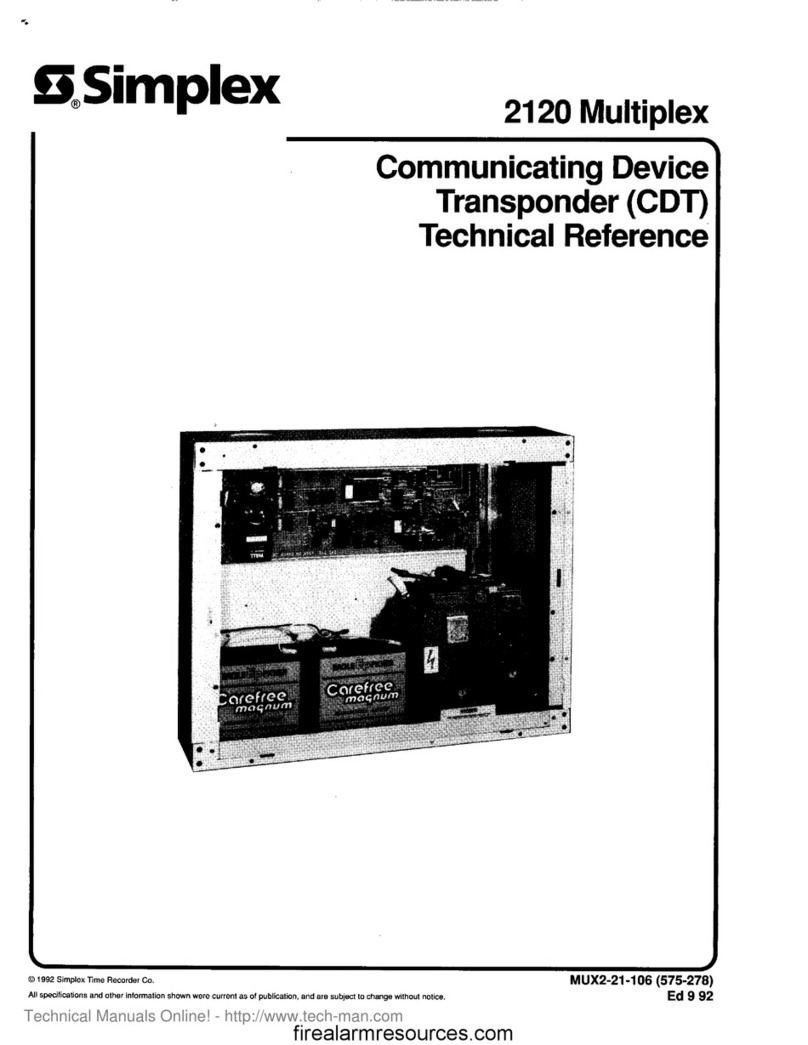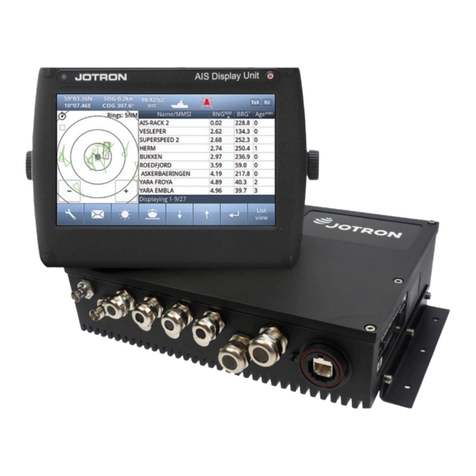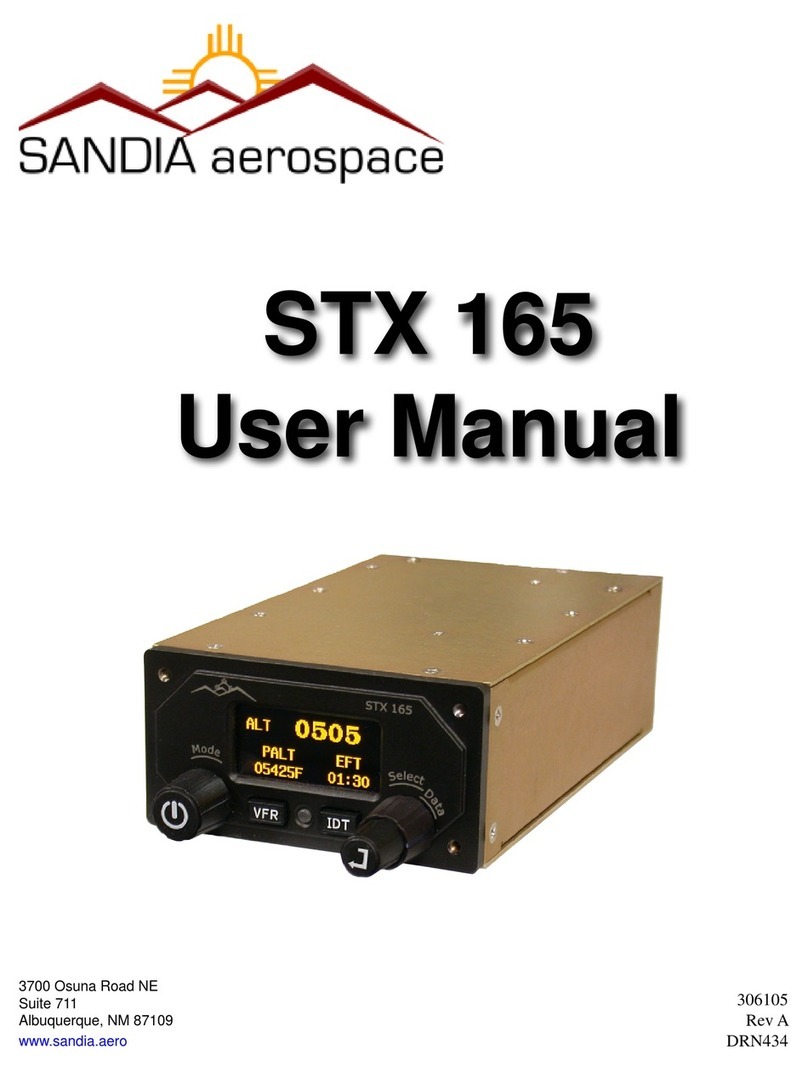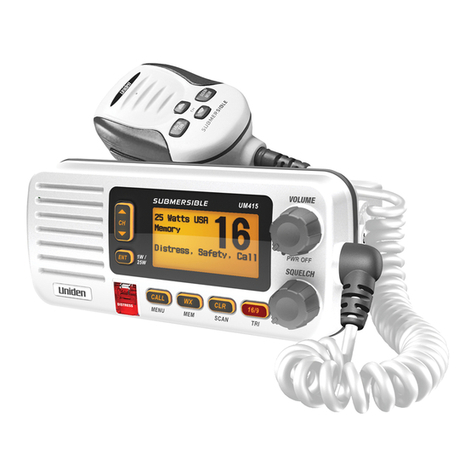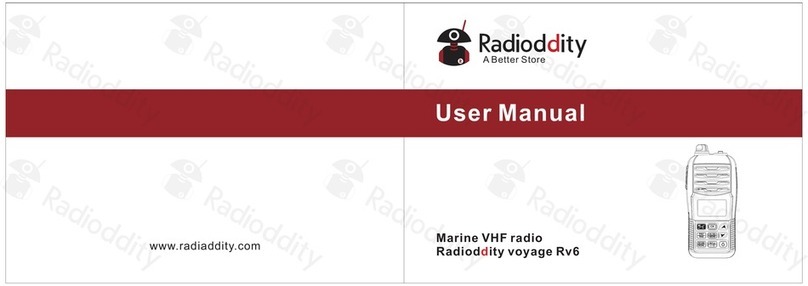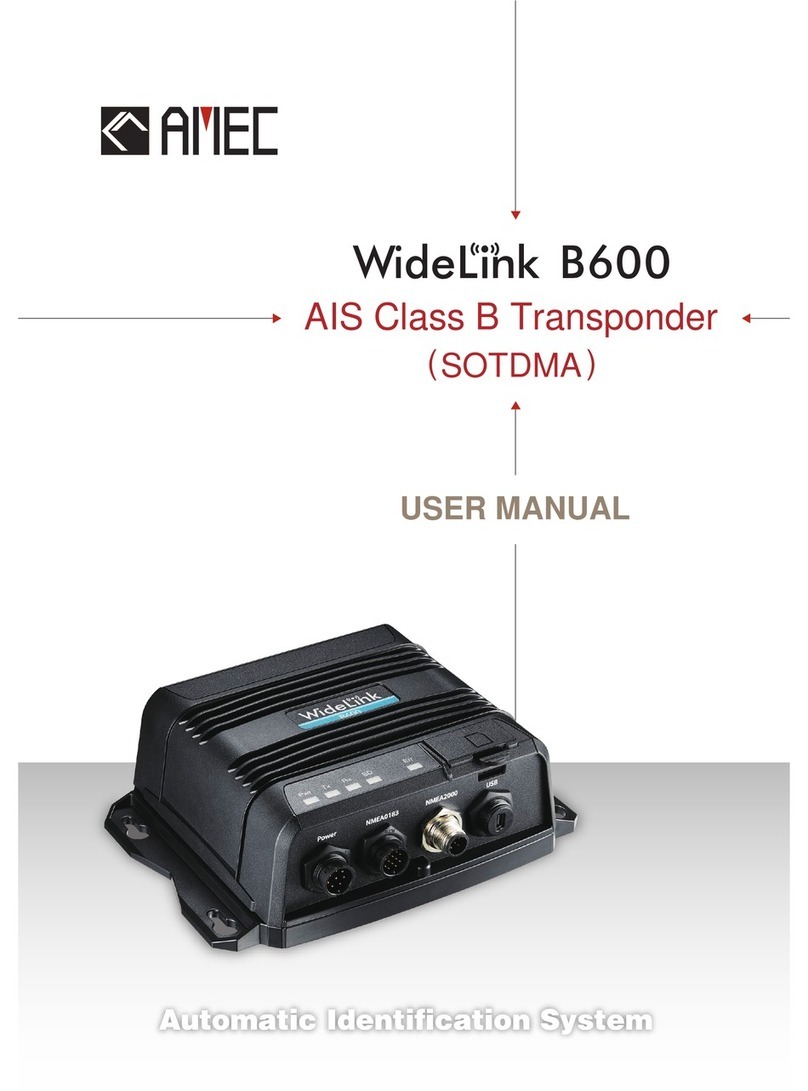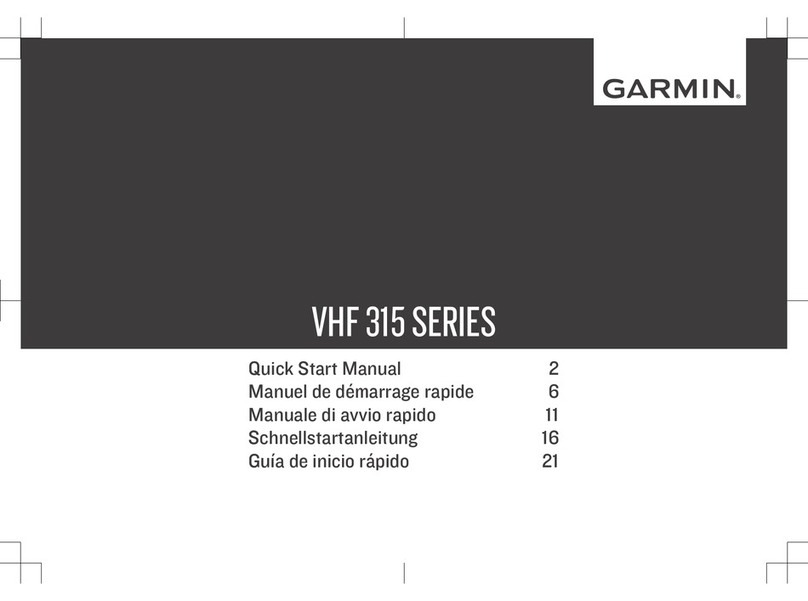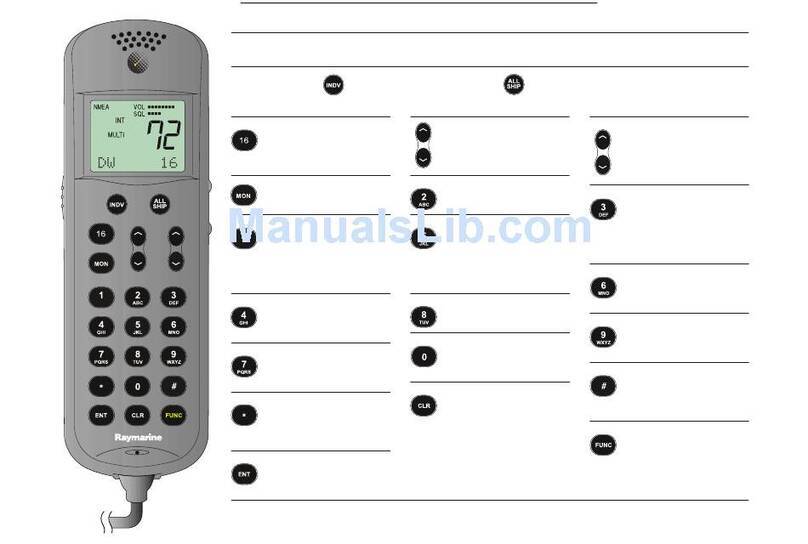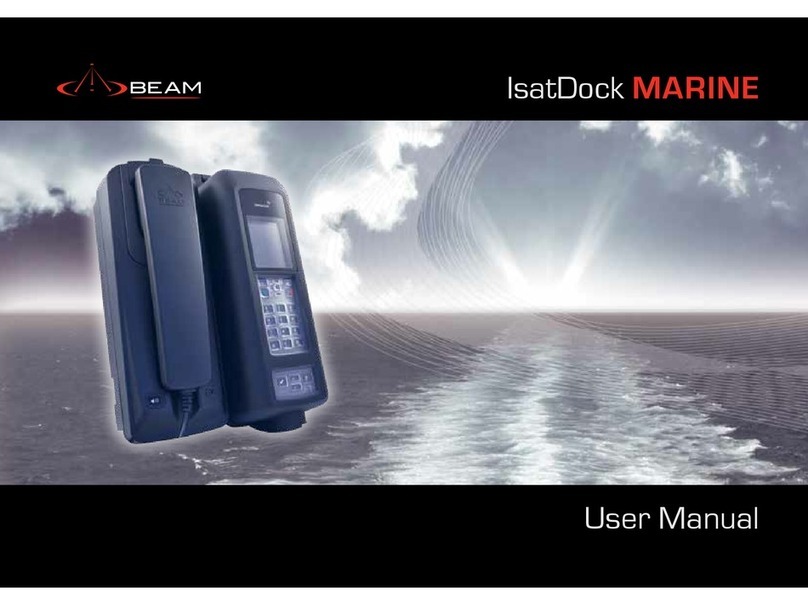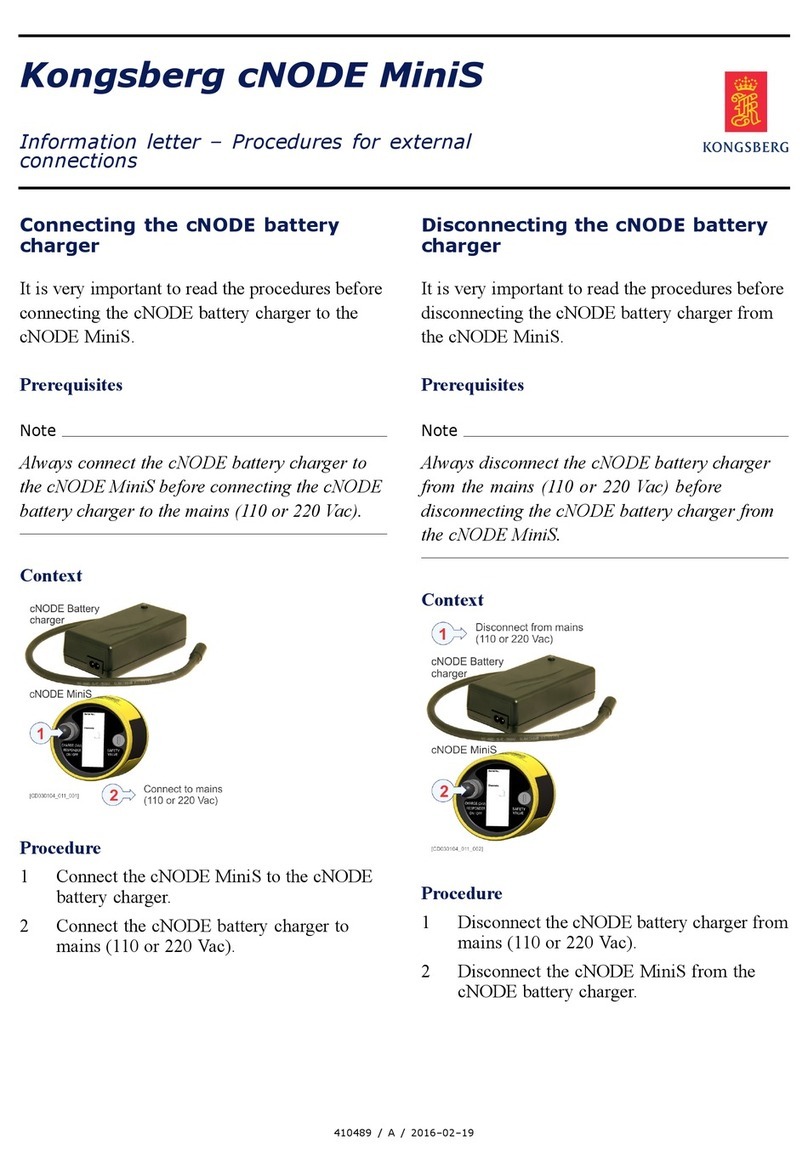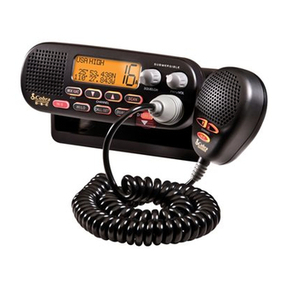Gotting HG G-98810-C User manual

Device Description HG G-98810-C | English, Revision 08 | Date: 28.06.2021
3
Table of Contents
Contents
1 About this Document........................................................................ 6
1.1 Warning Notices.................................................................................................................... 6
1.2 Symbols ................................................................................................................................... 7
1.3 Definitions of Terms............................................................................................................. 7
1.4 Abbreviations ......................................................................................................................... 7
2 Introduction....................................................................................... 8
2.1 Variants .................................................................................................................................... 8
2.2 System Components............................................................................................................9
2.3 Introduction: Positioning with Transponders ............................................................... 9
2.3.1 Position Calculation with Transponders.................................................................... 9
2.3.2 Track Guidance with Transponders ..........................................................................10
2.3.3 Position Determination / Navigation ........................................................................11
2.4 Definitions.............................................................................................................................12
3 Mounting ......................................................................................... 13
3.1 Transponder .........................................................................................................................13
3.2 Transponder Antenna ........................................................................................................13
4 Commissioning ............................................................................... 15
5 Components and Operation ...........................................................19
5.1 Components in the Ground .............................................................................................19
5.1.1 Transponders ...................................................................................................................19
5.1.2 Code Structure ................................................................................................................19
5.2 Transponder Antenna ........................................................................................................19
5.2.1 Connectors .......................................................................................................................20
5.2.1.1 Power.............................................................................................................................20
5.2.1.1.1 Power RS 232 Variant HG G-99810YC ...........................................................20
5.2.1.1.2 Power RS 422 Variant HG G-99810ZC............................................................20
5.2.1.2 CAN Bus ........................................................................................................................20
5.2.2 Turn-On Characteristics ...............................................................................................21
5.2.3 Interfaces ..........................................................................................................................21
5.2.3.1 Serial (RS 232) ............................................................................................................21
5.2.3.1.1 List of the System Data which can be Output..............................................21
5.2.3.1.2 List of Commands..................................................................................................23
5.2.3.2 System Monitor ..........................................................................................................26
5.2.3.3 CAN ................................................................................................................................26
5.2.3.3.1 Description...............................................................................................................26
5.2.3.3.2 CAN Message Object 1 (Transmission Object).............................................26
5.2.3.3.3 CAN Message Object 2 (Transmission Object).............................................27
5.2.3.3.4 CAN Message Object 4 (Reception Object)...................................................27
5.2.3.4 Data Interface CANopen® .......................................................................................27
5.2.3.4.1 Description of the Process Data Objects (PDO)...........................................27
5.2.3.4.2 Heartbeat..................................................................................................................28
5.2.3.4.3 Node Guarding........................................................................................................29
5.2.3.4.4 Description of the Service Data Objects (SDOs)..........................................29
5.2.3.4.5 Object Directory .....................................................................................................29
5.2.3.5 Positioning Pulse........................................................................................................29
5.2.4 Software Download .......................................................................................................29
5.2.5 Connection Cables .........................................................................................................30
6 Software .......................................................................................... 31
6.1 Terminal Program ...............................................................................................................31

Device Description HG G-98810-C | English, Revision 08 | Date: 28.06.2021
4Table of Contents
6.2 Parameter Presettings.......................................................................................................32
6.3 System Monitor ...................................................................................................................32
6.3.1 How to start the monitor program ............................................................................33
6.3.1.1 Procedure Monitor only............................................................................................33
6.3.1.2 Procedures 3964R/transparent..............................................................................33
6.3.2 How to Work with the Monitor Program .................................................................34
6.3.2.1 Main menu....................................................................................................................34
6.3.2.2 (S)erial Output .............................................................................................................36
6.3.2.3 (T)ime & Code..............................................................................................................37
6.3.2.4 (F)requency & Antenna Tuning ..............................................................................39
6.3.2.5 C(A)N-Parameters ......................................................................................................40
6.3.2.6 CANopen® ....................................................................................................................41
6.3.2.7 (D)isplay Systemstatus .............................................................................................42
6.3.2.8 Cs(v)................................................................................................................................42
6.3.2.9 Display (Y)Histogram.................................................................................................43
6.3.2.10 (L)oad User parameters to EEProm ......................................................................43
6.3.2.11 (U)pdate Firmware .....................................................................................................43
6.3.2.12 Import (1) / export (2) User Parameter ................................................................44
6.3.2.13 P(r)int Parameters ......................................................................................................44
6.4 Software Update (Antenna Software) ..........................................................................44
6.4.1 Installation of the Program for Software Update .................................................44
6.4.2 Software Update .............................................................................................................45
7 Maintenance ....................................................................................46
8 Trouble Shooting.............................................................................47
9 Technical Data.................................................................................48
10 Appendix ..........................................................................................49
10.1 Procedure 3964R ................................................................................................................49
10.1.1 Data Direction Antenna –> PLC .................................................................................49
10.1.2 Data Direction PLC –> Antenna .................................................................................49
10.2 Procedure „transparent“ ...................................................................................................50
10.3 Data direction antenna -> PLC........................................................................................50
10.3.1 Data direction PLC -> antenna ...................................................................................50
10.4 Overview of the CANopen® directory ..........................................................................50
10.4.1 Communication specific Entries within the Range of 0x1000 to
0x1FFF ...............................................................................................................................51
10.4.2 Manufacturer specific Entries starting at 0x2000 ................................................52
10.4.3 Standardized Device Profile higher than 0x6000 .................................................52
10.5 Details of the CANopen® directory ...............................................................................53
10.5.1 Device Type ......................................................................................................................53
10.5.2 Error Register...................................................................................................................53
10.5.3 COB-ID SYNC message ................................................................................................53
10.5.4 Device Name ....................................................................................................................54
10.5.5 Hardware Version ...........................................................................................................54
10.5.6 Software Version ............................................................................................................54
10.5.7 Save Parameters.............................................................................................................54
10.5.8 Restore Default Parameter ..........................................................................................54
10.5.9 Producer Heartbeat Time .............................................................................................55
10.5.10 Identity Object .................................................................................................................55
10.5.11 Transmit PDO_1 Parameter ........................................................................................55
10.5.12 Transmit PDO_2 Parameter ........................................................................................56
10.5.13 Mapping TPDO_1 ...........................................................................................................56
10.5.14 Mapping TPDO_2 ...........................................................................................................57
10.5.15 Device Parameter ...........................................................................................................58
10.5.16 Codes for System Configuration................................................................................59
10.5.17 Manufacture Parameter – Node Parameter ...........................................................59
10.5.18 8 Bit Digital Input (Transmission in TPDO_2) ........................................................60
10.5.19 16 Bit Status (Transmission in TPDO_1) .................................................................60

Device Description HG G-98810-C | English, Revision 08 | Date: 28.06.2021
5
Table of Contents
10.5.20 32 Bit Transponder Code .............................................................................................60
10.5.21 8 Bit Analog Inputs ........................................................................................................60
10.5.22 16 Bit Analog Inputs ......................................................................................................60
10.6 EDS Configuration File......................................................................................................61
10.7 Accuracy of the deviation calculation ..........................................................................61
10.8 Mechanical Drawing with Antenna Dimensions .......................................................63
11 List of Figures .................................................................................64
12 List of Tables................................................................................... 65
13 Index ................................................................................................ 67
14 Copyright and Terms of Liability ................................................... 69
14.1 Copyright ...............................................................................................................................69
14.2 Exclusion of Liability..........................................................................................................69
14.3 Trade Marks and Company Names ...............................................................................69

Device Description HG G-98810-C | English, Revision 08 | Date: 28.06.2021
6Chapter 1 – About this Document
1About this Document
For you to be able to use your product simply and safely this device description uses
consistent warning notices, symbols, terms and abbreviations. Those are described
in the following sections.
1.1 Warning Notices
In this device description warning notices appear before sequences of actions that
may lead to damage to persons or property. The listed actions for the danger preven-
tion have to be observed.
Warning notices have the following structure:
The warning symbol (warning triangle) indicates danger to life or risk of injury.
The signal word indicates the severity of the danger.
The paragraph kind or source of the danger names the kind or source of the
danger.
The paragraph consequences describes the consequences of not observing
the warning notice.
The paragraphs for danger prevention explain, how to avoid the danger.
The signal words have the following meanings:
SIGNAL WORD
Kind or source of the danger
Consequences
Danger prevention
Table 1 Hazard classification according to ANSI Z535.6-2006
Warning Symbol, Signal Word Meaning
DANGER
DANGER indicates a hazardous situation
which, if not avoided, will result in death or
serious injury.
WARNING
WARNING indicates a hazardous situation
which, if not avoided, could result in death or
serious injury.
CAUTION
CAUTION indicates a hazardous situation
which, if not avoided, could result in minor or
moderate injury.
NOTICE
NOTICE indicates property damage: The
product or the environment could be dam-
aged.

Device Description HG G-98810-C | English, Revision 08 | Date: 28.06.2021
7
About this Document – Chapter 1
1.2 Symbols
In this device description the following symbols and formatting are used:
If this information is ignored,
the product may not be operated in an optimal way.
Indicates one or more links to the Internet.
–www.goetting.de/xxx
–www.goetting.de/yyy
Indicates tips for easier
operation of the product.
The check mark lists a requirement.
The arrow shows an action step.
The indentation shows the result of an action or an action sequence.
Program texts and variables are indicated through the use of a fixed width
font.
Menu items and parameters are shown in cursive characters.
Whenever the pressing of letter keys is required for program entries, the
required /etter .eys are indicated as such (for most programs by Götting
small and capital letters are equally working).
1.3 Definitions of Terms
Transponder
RFID Tag (mark) in/on the ground or mounted on moving parts, which is inductively
supplied with energy by the antenna and then with this energy sends his code at half
the frequency.
Posipulse
Also called middle signal, short for position impulse. With the position impulse the
time of crossing the reference axis can be transmitted by telegrams without time lag.
Energy coil
Coil whose generated alternating magnetic field supplies the transponder with en-
ergy. For some antennas, the code emitted by the transponder is also received via
this coil.
Nibble
A nibble (rarely called nybble or nyble) is a amount of data containing four bits; it is
also called a half byte (source: Wikipedia). The transponder code comprises 16 bits,
i.e. four nibbles. Thus four hexadecimal code digits can be represented.
1.4 Abbreviations
AGV Automated Guided Vehicle
RFID Radio-Frequency Identification
EDS Electronic Data Sheet, configuration file for CAN bus systems

Device Description HG G-98810-C | English, Revision 08 | Date: 28.06.2021
8Chapter 2 – Introduction
2Introduction
The transponder antenna is designed to be used for the positioning with and evalu-
ation of passive transponders (RFID). This information can be used by superordinate
navigation systems (e.g. the Götting navigation controller HG G-73650). Those sys-
tems can then guide Automated Guided Vehicles (AGV) contact-free. All important
parameter settings, calibrations and updates are carried out via an integrated serial
interface or CANopen®.
Figure 1 Examples of automated vehicles using transponder systems
The antenna HG G-98810-C is a so-called 1.5 dimensional, meaning that it outputs
the Transponder code as well as the linear deviation rectangular to the direction of
travel as well as the information Before transponder, Crossing of the transponder (Po-
siPulse) and Behind transponder.
This system description refers to Transponder Positioning Antenna HG G-98810-C
with the firmware 98810C11.004 or higher (also refer to Figure 16 on page 34).
2.1 Variants
The serial signal is made available via potentially separated RS 422 or RS 232 inter-
faces. In addition, the positioning pulse is galvanically insulated. Furthermore a CAN
Bus interface, galvanically insulated as well, is included. The variants shown in Table
2below are available, they can be distinguished by the second to last character of
the product number, e.g. HG G-98810ZC.
Table 2 Variants overview
Variant Interfaces
HG G-98810ZC RS 422, CAN
HG G-98810YC RS 232, CAN

Device Description HG G-98810-C | English, Revision 08 | Date: 28.06.2021
9
Introduction – Chapter 2
2.2 System Components
The 1.5-dimensional Positioning and Identification System using the antenna HG G-
98810-C consists of up to four different components:
Figure 2 System components
1. Transmitter-receiver antenna HG G-98810-C incl. interpreter
(also refer to section 5.2 on page 19)
2. Transponder (within the track; refer to section 5.1.1 on page 19)
–HW DEV00095/HW DEV00098 or
–HG G-71325XA
3. Connection cables
(not in this picture; refer to section 5.2.5 on page 30)
4. Optional transponder programmer HG G-81840ZA
(not in this picture; refer to separate data sheet)
2.3 Introduction: Positioning with Transponders
The positioning with transponders is based on the fact that the transponder antenna
can detect a transponder at the nominal reading distance and calculate its position
in the antenna field. Usually the transponders are installed at fixed positions on the
ground and the antenna moves above them, e.g. when it is mounted underneath a
vehicle that drives along the track. Alternatively the antenna may be installed at a
fixed position and the transponder is moved relatively to it, e.g. by a robot‘s arm or
on a monorail. In this description we refer to the application with AGVs with tran-
sponders on or within the roadway.
2.3.1 Position Calculation with Transponders
The functional principle behind the transponder positioning is that the antenna per-
manently sends out an energy field with its transmission frequency onto the area un-
derneath its reading side. The transponders are passive and don‘t need an internal
power supply. As soon as the antenna moves over a transponder the transponder is
supplied with energy inductively. It automatically awakes and uses the transmitted
energy to send back its code at half the antenna‘s frequency. This means that only
certain transponders and antennas can work together that use matching frequen-
cies. Furthermore there are different systems for the transmission and decoding of
the code.

Device Description HG G-98810-C | English, Revision 08 | Date: 28.06.2021
10 Chapter 2 – Introduction
Figure 3 Sketch: 1.5-dimensional Positioning with transponders (no X deviation calculation)
As soon as a transponder starts sending inside the antenna field the antenna reads
the transponder‘s individual code and interpolates the position of the transponder‘s
electro-magnetic field inside the antenna field. The antenna forwards this informa-
tion to the superordinate vehicle control via its interfaces. Thus the vehicle knows at
which point underneath the antenna the transponder is (Y deviation). Additionally
the antenna outputs the information Before transponder, Crossing of the transponder
in direction of travel (PosiPulse) and Behind transponder.
2.3.2 Track Guidance with Transponders
Driverless vehicles (AGV) follow a pre-defined course. The vehicles usually are
equipped with sensors for the position estimation via distance measurement, a so-
called odometry1. Incremental encoders count the revolutions of the wheels. A su-
perordinate control unit then calculates the traveled distance and the orientation of
the vehicle by taking into account the circumference of the wheels and the steering
angle. The odometry has the advantage that it is available nonstop. However the po-
sition accuracy calculated by the odometry deteriorates the further the vehicle trav-
els, e.g. because of slippage.
At this point the transponder system comes into operation. The transponders in the
ground are placed at exactly measured positions and are used punctual to deter-
mine the exact position of the vehicle. The superordinate navigation system or the
navigation controller (both not part of the scope of supply of the transponder anten-
na) resets its estimated position at these points to the exact position.
Figure 4 Sketch: Track guidance with odometry and transponders
1. Odometry (from old greek όδός hodós „route“ and μέτρον métron „measure“ — thus „distance
measurement“) refers to a method to estimate the position and orientation of a mobile system
on the basis of its drive system.
1
3
2
Transponder
Transponder
Lcal coordinate system
Antenna
Ground
X
Vehicle
Direction of travel
Antenna
SIDE VIEW
Y
X3
X2
X1
Y2Y1Y3
Transponder
midpoint
ΔY
Transponder
Antenna
TOP VIEW
Center axis
PosiPulse
Before Transp.
Behind Transp.
Transponder-Antenna
Transponder
Navigation point
Virtual track
Wheels with incremental encoders
Bogie Pivot point
Steering angle (from navigation controller)
Offset antenna midpoint <—> Navigation point in X and Y direction
Deviation odometry
to actual position
Vehicle
Direction of travel (X direction)

Device Description HG G-98810-C | English, Revision 08 | Date: 28.06.2021
11
Introduction – Chapter 2
The distances between the transponders thus can only be so long that it is still en-
sured that the vehicle guided with the odometry does not deviate so far from the
track that the transponder antenna does not hit the next transponder. The closer the
transponders are placed the higher the accuracy of the track guidance. However
since the installation of the transponders is relatively elaborate that for each combi-
nation of track and vehicle an average value is to be determined. Still for sections
with extensive driving maneuvers many transponders are needed.
When using two transponder antennas on one vehicle especially omnidirectional ve-
hicles are able to determine their position and orientation clearly. For this to work it
must be ensured that under each antennas there is a transponder simultaneously.
2.3.3 Position Determination / Navigation
A superordinate navigation system (e.g. the Götting navigation controller, see below)
calculates the position of the vehicle on the track by taking the following things into
account: The known position of the antenna underneath the vehicle (usually with
offset towards the navigation point), the measured relative position of the transpon-
der in the antenna field and the known position of the transponder in the local coor-
dinate system (definition via transponder list). As soon as several transponders have
been read consecutively the orientation of the vehicle can also be calculated.
Figure 5 Sketch: Free navigation with transponders
For the path planning the navigation controller has the driving course in its memory.
The driving course is subdivided into segments. The segments themselves are sub-
divided into virtual support points that form the virtual track. The navigation control-
ler then calculates the route to targets as sequences of segments that the vehicle
has to travel along. While driving the navigation controller leads the vehicle from
support point to support point. For this it interpolates the route across several sup-
port points, sets the driving speed and calculates the steering angles for curves. Ev-
ery time a transponder is reached it determines the difference between the position
from the odometry and the actual position and calculates the correction path that
brings the navigation point back to the virtual track.
Götting has developed the navigation controller HG G-73650 which can process the
data from common incremental encoders. Additionally it is able to use different Göt-
ting positioning systems to calculate the actual position of the vehicle.
It can e.g. use the transponder antenna described in this document, the laser scan-
ner, guide wire sensors, magnet sensors and even GPS signals for the position de-
termination. Additionally it manages tracks and converts the positions of the sensors
installed on the vehicle into the coordinate system of the site. It also takes into ac-
count the technical possibilities of a specific vehicle (possible curve radius, wheel
T
T
T
T
T
T
T
T
T
T
Transponder antenna
Transponder
Navigation point
Vitual track
Calculation of the path
Virtual support points on the track for the navigation
Vehicle
Direction of travel (X direction)
with turnoff
to the support point

Device Description HG G-98810-C | English, Revision 08 | Date: 28.06.2021
12 Chapter 2 – Introduction
circumference, maximum speed, etc.) when calculating paths. Then it can tell the
vehicle controller into which direction and with which speed the vehicle should
move.
You can find more information about the navigation controller here:
http://www.goetting-agv.com/components/73650
2.4 Definitions
The definitions and signatures used for this system and in this device description are
defined according to the following drawing:
Figure 6 Polarity of the deviation
For definition of bit Segment see Table 8 on page 23. This bit is set in the half plane
-X.
-Y <– Deviation –> +Y
<– Direction of Travel –>
Active area for positioning
Bottom
View
+X -X

Device Description HG G-98810-C | English, Revision 08 | Date: 28.06.2021
13
Mounting – Chapter 3
3Mounting
3.1 Transponder
Observe the required minimum distances from metal, as the influence on position-
ing accuracy and range is dependent upon size and distance of metal parts. For the
same reason, the transponder should be mounted as vertically aligned as possible.
Please observe the data sheets and mounting instructions for the suitable transpon-
ders HG G-71325XA and HW DEV000950/HW DEV0098.
3.2 Transponder Antenna
Figure 7 Antenna Mounting Holes
The transponder antenna can be installed with four M6 screws (not in the scope of
supply). Those are inserted from the reading side. On the mounting side there are
constrictions inside the antenna casing (approx. 2 cm long), through which the
screw head does not slide. Here the screw head seats solidly. Then the screws can
be fixated from the vehicle side.
To prevent any adverse effects on the system:
The Antenna itself may be mounted directly onto metal with its mounting side.
No closed loop within 300 mm around the antenna, especially around the cover.
No metal surfaces nearer than 50 mm (essential antenna connection cabling
and special mounting struts excluded).
For optimal operation of the transponder system, it is essential that there are no
interfering signals in the frequency range of 64 ±4 kHz (e. g. chopped engines,
etc.)!
Current-carrying wires except the connection cable of the antenna itself have to
be far enough away from the antenna (minimum 150 mm) so that their power
and frequencies does not influence the antenna too much, its sum voltage in
idle mode has to be below 50 and during driving below 100 (guideline: For very
high or very small reading distances those values may be higher/lower. The sum
voltage without a transponder in the reading area should always be smaller
than half the sum voltage that is generated by a transponder within the reading
area).
200
580
6,5
O
Top View / Reading Side
Position of Mounting Holes

Device Description HG G-98810-C | English, Revision 08 | Date: 28.06.2021
14 Chapter 3 – Mounting
Transponder antennas with the same energy field frequency may not be posi-
tioned too close to each other since then beat frequencies can change the
energy supply to the transponders. This can e.g. be observed when the energy
consumption of the antenna is not constant or via unsteady reception voltages.
Tests with the antenna HG G-98810-C showed that gaps of 300 mm (in longitu-
dinal and lateral direction) had no effect. If the distance between two antennas
shrinks to 200 mm the sum voltage decreases by up to 6 %. Placing two anten-
nas only 100 mm apart the sum voltage sways by +5% to -15%. Decoding and
distance calculation still work under those conditions but there is a risk, that set
thresholds are undershot.
Steel reinforcement structures located very close to the surface of the runway
may transform the Antenna energy in the ground to deviating locations in such
a way that the measured Transponder position is a faulty one.
For the complete mechanical drawing please see annex 10.8 on page 63.

Device Description HG G-98810-C | English, Revision 08 | Date: 28.06.2021
15
Commissioning – Chapter 4
4Commissioning
Check the operating voltage before connecting! The cables should not lie directly
next to power supply cables.
Connect the antenna with the vehicle control unit. Connect a laptop to the antenna
using the serial interfaces of both devices. Then start the monitor program as de-
scribed in section 6.3 on page 32.
Default Values: As standard setting, the system uses the Monitor only setting
at 38400 baud. However, please pay attention to the fact that these may have been
altered by a different user!
1. Move a transponder into reception range.
The voltage Sshown in the monitor program‘s status bar should increase con-
siderably. The code must be detected immediately and the number of readings
must be continuously counted up to 255.
2. Remove the transponder from the reception range.
While no transponder is located within the antenna field, the voltage Smust
decrease to a very small value. The display of the code and the number of read-
ings, if applicable, remains identical. If this is not the case, interferences in the
frequency range of 64 kHz are being induced.
The causes for the interferences should be eliminated as far as possible. If this is not
possible it might be possible to avoid the critical frequency area by changing the side
band (see section 6.3.2.4 on page 39).
3. In order to adjust the antenna to environmental influences it must be re-cali-
brated (also refer to section 3.2 on page 13), alternatively activate the function
Auto-Tune (refer to section 6.3.2.4 on page 39).
As long as no errors have occurred, save any altered parameters and exit the monitor
program. If certain parameters are altered, a system reset is necessary (turn off and
reactivate the antenna). Where this is applicable is described in the corresponding
sections of the monitor program (section 6.3). Now the system has been correctly
put into operation. For the correct adjustment of the positioning thresholds the ve-
hicle has to be used in its final operation environment or in a test site that very close-
ly resembles it.
4. In order to set the positioning thresholds position the vehicle over a transponder
that is mounted in the track. Initially set the positioning thresholds that a signal
that is 50 % weaker than the one received from the transponder still would trig-
ger the generation of a positioning pulse (see section 6.3.2.3 on page 37).
5. In order to set the positioning threshold correctly (refer to section 6.3.2.3 on
page 37), it is useful to record a complete test run over the set track. The serial
interface of the antenna HG G-98810-C may be used accordingly (refer to sec-
tion 5.2.4 on page 29). For this function Antenna HG G-98810-C offers the use
of the serial interface (refer to section 5.2.3.1 on page 21) or the CAN bus mes-
sage object 3 (see section Table 11 on page 27). Afterwards adjust the position-
ing thresholds so that a safe positioning is possible but that is not triggered by
side lobes. Figure 8 shows a corresponding driving situation, for readings like
this a reasonable threshold for the decoding and the positioning pulse would be
between 400 and 600 units.

Device Description HG G-98810-C | English, Revision 08 | Date: 28.06.2021
16 Chapter 4 – Commissioning
Figure 8 Side lobes during a transponder reading
If during the first driving tests a proper track guidance is not possible try changing
the positioning thresholds accordingly.
The separately adjustable thresholds are explained in chapter 6 on page 31. In order
to explain those thresholds and how to find a proper set-up below the process of a
transponder crossing is described.
Every 2 ms a check is performed whether the sum voltage exceeds the value
„Threshold for Decoding“. If that is the case the bit TRANS_IN_FIELD is set and the
NOISE counter is incremented. Every 8 ms it is attempted to read a code. If a code
is read the NOISE counter is reset and afterwards the code is re-read until the Num-
ber of equal Codes is reached. If this is successful the bit CODE_OK is set.
As soon as the NOISE counter exceeds the threshold Level to Noise Error
the bit RX_NOISE is set.
The bit CODE_OK is held until either the sum voltage falls below the value Th-
reshold for Decoding or the bit RX_NOISE is set.
A new transponder code can only be read when the bit CODE_OK is reset.
This means that if there are high interference voltages in the 64 kHz area the anten-
na will not read a new transponder code after leaving the reception range of a tran-
sponder for the period of 2 ms * Level to Noise Error. In case a new tran-
sponder enters the reception range during this period the NOISE counter is reset but
the old code is held.
The following diagrams show examples of recorded data:
Undisturbed Transponder Decoding
Main field
Side lobes
Transponder Reading
Transponder Number
Reception voltage US/units

Device Description HG G-98810-C | English, Revision 08 | Date: 28.06.2021
17
Commissioning – Chapter 4
Figure 9 Undisturbed decoding across two transponders
Figure 10 The same driving situations as shown in Figure 9 only with antenna with wrong cal-
ibration
Figure 11 The same driving situation as shown in Figure 9, this time with high noise level
0
100
200
300
400
500
600
700
800
900
1000
0
0
0
0
1632
1632
1632
1632
1632
1632
1632
1632
1632
1632
1632
1632
1632
1632
1632
1632
1632
1632
1632
1632
1632
1632
1632
1632
1632
1632
1632
1632
1632
1632
1632
1632
1632
1632
1632
1632
1632
1632
1632
2049
2049
2049
2049
2049
Us C_OK code_count err_count POSI
Undisturbed Transponder Decoding
0
100
200
300
400
500
600
700
800
900
1000
0
0
0
0
1632
1632
1632
1632
1632
1632
1632
1632
1632
1632
1632
1632
1632
1632
1632
1632
1632
1632
1632
1632
1632
1632
1632
1632
1632
1632
1632
1632
1632
1632
1632
1632
1632
1632
1632
1632
1632
1632
1632
2049
2049
2049
2049
2049
Us C_OK code_count err_count POSI
Damped Transponder Decoding
0
100
200
300
400
500
600
700
800
900
1000
0
0
0
0
1632
1632
1632
1632
1632
1632
1632
1632
1632
1632
1632
1632
1632
1632
1632
1632
1632
1632
1632
1632
1632
1632
1632
1632
1632
1632
1632
1632
1632
1632
1632
1632
1632
1632
1632
1632
1632
1632
1632
1632
1632
1632
1632
2049
2049
2049
2049
2049
2049
2049
2049
Us CODE_OK code_count err_count POSI
Transponder decoding with interference voltage

Device Description HG G-98810-C | English, Revision 08 | Date: 28.06.2021
18 Chapter 4 – Commissioning
When comparing the diagrams one can see that the wrong calibration shown in Fig-
ure 10 on page 17 makes the sum voltage drop and thus the reception periods for
Code_OK and POSI decrease. This can lead to decoding problems for higher cross-
ing speeds.
In Figure 11 on page 17 the code of the weaker transponder is read correctly how-
ever the position measuring can no longer be performed correctly.
Although sum and difference are called voltages those two values are in fact no volt-
ages but logarithmic derivations of the actual voltages.
For the test runs two transponders with different signal strengths have been crossed
shortly one after the other. The settings were:
Table 3 Reference values for the commissioning runs
Variable Set value
Level to Noise Error 250
Number of equal Codes 2
Threshold for Decoding 256
Level for Positioning/Calculation 256

Device Description HG G-98810-C | English, Revision 08 | Date: 28.06.2021
19
Components and Operation – Chapter 5
5Components and Operation
5.1 Components in the Ground
5.1.1 Transponders
As reference markers, transponders with the trovan® coding are used; e. g. the
HG G-71325XA transponder or the types HW DEV00095/HW DEV00098 (read
write/RW).
Range and accuracy of positioning are influenced by:
any large metal pieces (sheets) on the ground.
proximity of any floor reinforcement
inductive loops, as they are created e. g. by steel building mats, have a greater
influence. Individual metal poles have little effect. Those may partially be within
the metal-free area.
The following environmental conditions have no effect on the system:
snow, ice, water.
oil, tar, earth, dirt, etc.
5.1.2 Code Structure
The antenna HG G-98810-C is set up to receive only block number two with its 20
bits of user data.
Line (for 3 bits each) and column parities are used for data protection. The transmis-
sion time for a complete code telegram is 8 ms.
5.2 Transponder Antenna
Figure 12 Photo Transponder Antenna HG G-98810-C and two transponders
The antenna systems and the pre-amplifiers are housed in a casing with the dimen-
sions shown in annex 10.8 on page 63. The cables (the connectors) exit at one side
of the antenna. The interpreter is integrated in the antenna casing. The electronics
are varnished. For a mechanical drawing please see annex 10.8 on page 63.

Device Description HG G-98810-C | English, Revision 08 | Date: 28.06.2021
20 Chapter 5 – Components and Operation
5.2.1 Connectors
The antenna is equipped with three M12 connection sockets. Both antenna variants
have the same two CAN sockets. The pin assignment of the Power socket depends
on the variant. The pin allocations are as follows:
5.2.1.1 Power
Voltage Supply, Serial Interface and Positioning Pulse. The positioning pulse output
is fed from +Ub (24 V) and limited to 20 mA.
5.2.1.1.1 Power RS 232 Variant HG G-99810YC
5.2.1.1.2 Power RS 422 Variant HG G-99810ZC
5.2.1.2 CAN Bus
The CAN bus is connected to the device with two 5-pin M12 connectors male/fe-
male. They are named CAN1 and CAN2 and are allocated as follows:
Table 4 Power Interface RS 232 Variant HG G-98810YC
Power Pin Signal Annotation
1+Ub (24 V) Power supply
2Posi Positioning pulse output
20 mA current limited
3TxD RS232 data output
4RxD RS232 data input
5 GND Ground (supply)
Table 5 Power Interface RS 232 Variant HG G-98810ZC
Power Pin Signal Annotation
1+Ub (24 V) Power supply
2 GND Ground (supply)
3RX422+ RS422 data input
4RX422-
5TX422+ RS422 data output
6TX422-
7Posi Positioning pulse output
20 mA current limited
8Do not connect
NOTICE
Damage to CAN bus devices
If supply voltage is applied to pin 4 or 5, other devices connected to the CAN bus
may be damaged
Never connect the supply voltage to pin 4 or 5
M12 5-pin male
M12 8-pin male
45°
1
2
3
4
567
8
Other manuals for HG G-98810-C
2
This manual suits for next models
2
Table of contents
Other Gotting Marine Radio manuals


